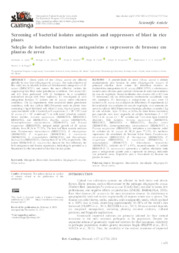Screening of bacterial isolates antagonists and suppressors of blast in rice plants.
Screening of bacterial isolates antagonists and suppressors of blast in rice plants.
Author(s): AJULO, A. A.; OLIVEIRA, R. S. de; BEZERRA, S. F.; COSTA, N. B.; GONÇALVES, A. R.; OLIVEIRA, M. I. de S.; FILIPPI, M. C. C. de
Summary: Grain yields of rice (Oryza sativa) are affected globally by rice blast (Magnaporthe oryzae). The main objective of this study was to identify isolates of rhizobacterial antagonists of M. oryzae (BRM10781) and screen the most effective isolates for suppressing rice blast under greenhouse conditions. Two assays (E1 and E2) were performed with 22 treatments in a completely randomized design with three replicates. E1 investigated in vitro antagonism between 21 isolates and M. oryzae under laboratory conditions. The E2 experiments were conducted under greenhouse conditions, with rice cultivar BRS Primavera seeds in plastic trays containing 3 kg of fertilized soil. After 21 days, the rice leaves were spray-inoculated with a bacterial cell suspension (1 × 108 CFU) and M. oryzae (3 × 105 conidia.mL-1) or with water (absolute control). Seven isolates, Serratia marcescens (BRM65918, BRM65923, BRM65926, and BRM63532), Bacillus cereus (BRM65919), Stenotrophomonas nitritireducens (BRM65917), and Priestia megaterium (BRM65929), reduced radial growth of M. oryzae colonies from 80.26 to 77.33%. The best leaf blast severity reducers were Pseudomonas nitroreducens (BRM32112), B. thuringiensis (BRM65928), P. megaterium (BRM65916), S. marcescens (BRM65918), S. nematodiphila (BRM63522), and Enterobacter hormaechei (BRM65925), varying from 97 to 95% respectively. The isolate BRM65918 (S. marcescens) showed the best efficiency for both antagonism and disease suppression, indicating its potential as a bioproduct for the biocontrol of rice blast in rice plants.
Publication year: 2024
Types of publication: Journal article
Unit: Embrapa Rice & Beans
Observation
Some of Embrapa's publications are published as ePub files. To read them, use or download one of the following free software options to your computer or mobile device. Android: Google Play Books; IOS: iBooks; Windows and Linux: Calibre.
Access other publications
Access the Agricultural Research Database (BDPA) to consult Embrapa's full library collection and records.
Visit Embrapa Bookstore to purchase books and other publications sold by Embrapa.

